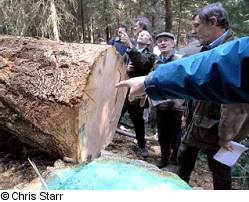Summary
Summary

Discussion about the management of Douglas fir at Stourhead (Western) Estate. Continuous Cover Forestry (CCF) allows for adding girth well beyond the usual 70 years, adding value beyond discount rates, and highlights the fact that CCF takes us into new areas of forest economics.
In addition to studying the social benefits of forestry, social science can contribute to the development of forest management through understanding communication pathways, and supporting the links between science and practice.
Continuous cover forestry (CCF) offers an ideal opportunity to explore the interactions between science, policy, public and practice, in the neglected area of social studies of forestry.
CCF or low impact silviculture is a relatively new approach to silviculture in Britain, and has been adopted to varying degrees in policy – explicitly in Woodlands for Wales, more aspirationally in the Scottish Forestry Strategy, and not at all in the Strategy for England’s Tree’s, Woods and Forests (ETWF). In England, private woodland owners are showing great interest, and are participating in a research network led by French foresters.
CCF has been promoted as an environmentally desirable alternative to conventional plantation forestry, delivering improved ecosystem services and a more adaptive silvicultural system (i.e. more climate proof), and is favoured by the revised UK Forestry Standard and UK Woodland Assurance Standard (UKWAS).
The study will help to develop a strong relationship between evidence, policy and practice and will support stakeholder engagement.
Research objectives
- To understand the relationships and processes that influence forest policy and practice, through the specific example of CCF
- To develop models for knowledge exchange between research, policy and practice.
Further reading
But is it science? (PDF-485K)
Article by Anna Lawrence for the Continuous Cover Forestry Group (CCFG) Newsletter – August 2008.
Continuous cover forestry: opinion and evidence (PDF-1188K)
Presentation given by Anna Lawrence at the CCFG workshop on ‘Silvicultural Systems for Tomorrow!’ in Llanidloes, Wales in October 2008.
Funders and partners
![]()
This research is an exploratory strand in the social research programme of Forest Research funded by the Forestry Commission.
Anna Lawrence is working closely with our Continuous cover silviculture research programme and the Continuous Cover Forestry Group (CCFG).
Forestry Commission policy
Woodlands for Wales (2001):
- Aim to convert at least half of the National Assembly woodlands to continuous cover over the next 20 years, where practical, and encourage conversion in similar private sector woodlands.
- Continue to gather information about continuous cover systems and how best to manage these systems for the range of benefits that society demands.
Status
This was an exploratory study running from May 2008 to March 2009.
Contact
General Content
Related pages
- Woodlands for Wales
- Scottish Forestry Strategy
- Strategy for England’s Tree’s, Woods and Forests
- UK Forestry Standard
